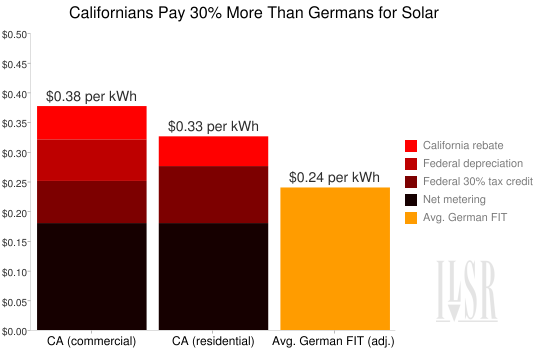This post originally appeared on Energy Self-Reliant States, a resource of the Institute for Local Self-Reliance’s New Rules Project.
The Golden State has covered over 50,000 roofs with solar PV in the past decade, but could it also save 30% or more on its current solar costs? Renewable energy guru Paul Gipe wrote up a study last month that found that Californians pay much more per kilowatt-hour of solar power than Germans do (accounting for the difference in the solar resource). The following chart outlines the various ways Californians pay for solar, compared to the Germans (averaged over 20 years, per kilowatt-hour – kWh – produced).

The German feed-in tariff (FIT) pays an average of 24 cents per kWh over 20 years for solar, but the combination of federal, state and utility incentives for solar PV in California have residents paying 33-38 cents per kWh.
While the study doesn’t explore the rationale, here are a few possibilities:
- The inefficiency of federal tax credits artificially inflates the cost of U.S. solar.
- Big banks that offer financing for residential solar leasing routinely overstate the value of the systems, increasing taxpayer costs on otherwise cost-effective systems.
- The complexity and intricacy of the state and federal incentives (4 separate pots of money!) and the lack of guaranteed interconnection means higher risk and higher cost for U.S. solar projects.
- The inconsistency in local permitting standards that increases project overhead costs.
Ultimately, the combination of these market-dampening problems in the California market has hindered the cost savings that have hit the German market. Prospective California solar installations of 25 kilowatts (kW) and 100 kW have a quoted price of $4.36 and $3.84 per Watt, respectively, according to the Clean Coalition. This compares to $3.40 per Watt on average for already installed projects of 10-100 kW in Germany.
Given the solar cost disadvantage presented in both the value of incentives AND in the actual installed cost, renewable energy advocates in California should seriously question whether the current policy framework makes sense. The mish-mash of federal tax credits and state/utility rebates has not led to the same economies of scale and market maturity as Germany has accomplished with their CLEAN Contract (a.k.a. feed-in tariff).
Switching energy policies could save ratepayers billions.
A 24-cent CLEAN contract price for California solar (to match the German contract) would replace the entire slate of existing solar incentives with an overall average cost 30% lower than the current combined incentives. If 2011 is a banner year and the state sees 1 gigawatt (GW) of installed capacity, the savings to ratepayers of a CLEAN program (over 20 years) would be nearly $3 billion.
If the CLEAN price were adjusted down to assume that projects could use the federal tax credit, then California could set the contract price as low as 18.5 cents per kWh, 5 cents less than is currently paid by California ratepayers (although requiring projects to use tax credits has significant liabilities).
Several states and municipal utilities (Vermont; Hawaii; Gainesville, FL; and San Antonio, TX) have already shifted to this simple, comprehensive policy, with promising early results. Californians should consider whether holding to an outdated and complicated energy policy is worth paying billions of dollars extra for solar power.


